Business Plan for the Sydney Symphony Orchestra: A Strategic Analysis
VerifiedAdded on 2023/06/07
|14
|3273
|208
Report
AI Summary
This report presents a detailed business analysis of the Sydney Symphony Orchestra (SSO), aiming to develop a sustainable business model. It begins with a historical overview of the SSO, followed by a PESTEL analysis to assess the political, economic, social, technological, legal, and environmental factors influencing the orchestra. Porter's Five Forces model is then applied to evaluate the competitive landscape, including threats from new entrants, substitutes, and the bargaining power of buyers and suppliers. The analysis identifies direct and indirect competitors, opportunities, and threats, both internal and external. The report proposes business and cooperative strategies to enhance the SSO's performance, improve its market position, and ensure long-term viability, concluding with recommendations for future development. The report uses Harvard referencing style.
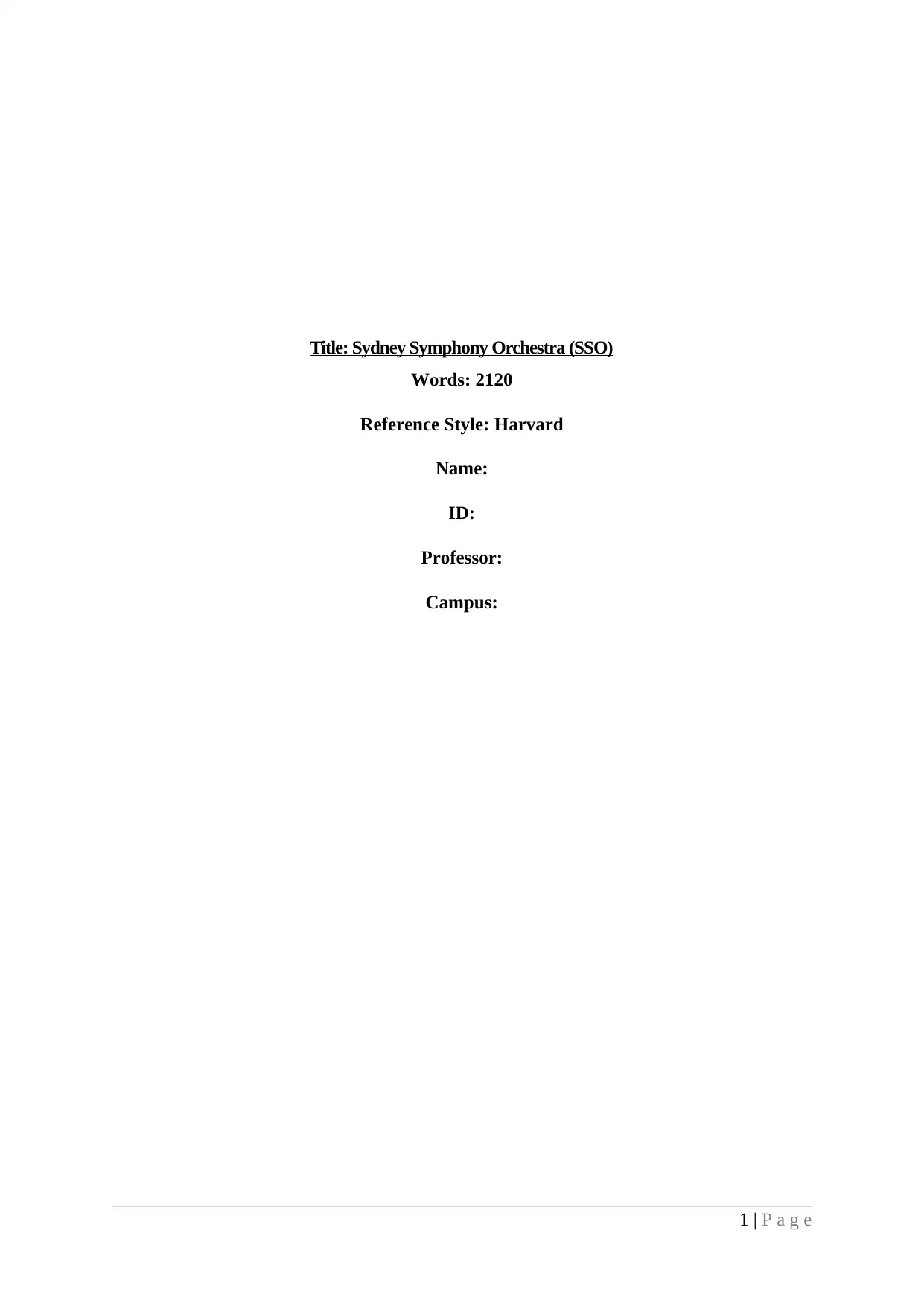
Title: Sydney Symphony Orchestra (SSO)
Words: 2120
Reference Style: Harvard
Name:
ID:
Professor:
Campus:
1 | P a g e
Words: 2120
Reference Style: Harvard
Name:
ID:
Professor:
Campus:
1 | P a g e
Secure Best Marks with AI Grader
Need help grading? Try our AI Grader for instant feedback on your assignments.
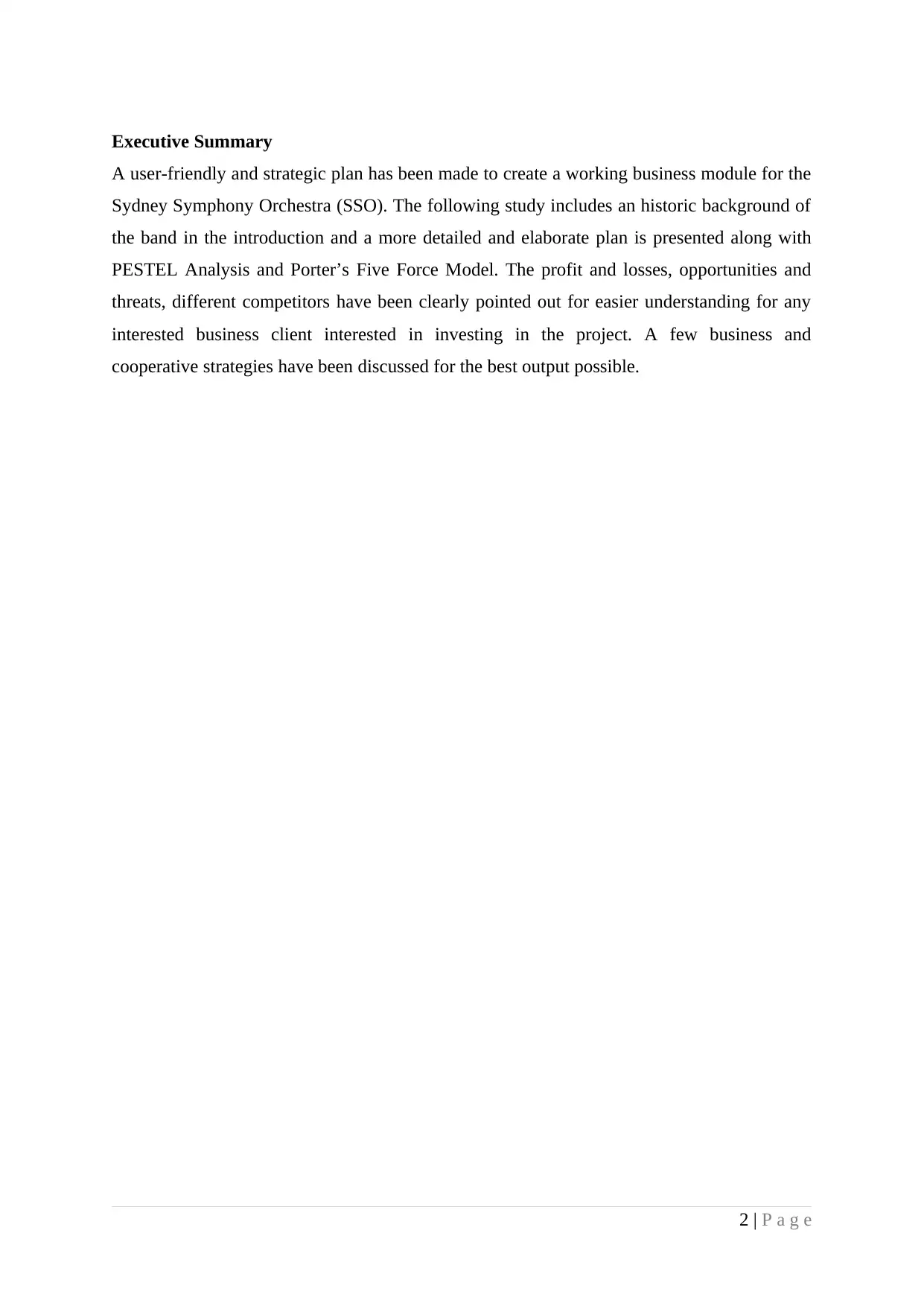
Executive Summary
A user-friendly and strategic plan has been made to create a working business module for the
Sydney Symphony Orchestra (SSO). The following study includes an historic background of
the band in the introduction and a more detailed and elaborate plan is presented along with
PESTEL Analysis and Porter’s Five Force Model. The profit and losses, opportunities and
threats, different competitors have been clearly pointed out for easier understanding for any
interested business client interested in investing in the project. A few business and
cooperative strategies have been discussed for the best output possible.
2 | P a g e
A user-friendly and strategic plan has been made to create a working business module for the
Sydney Symphony Orchestra (SSO). The following study includes an historic background of
the band in the introduction and a more detailed and elaborate plan is presented along with
PESTEL Analysis and Porter’s Five Force Model. The profit and losses, opportunities and
threats, different competitors have been clearly pointed out for easier understanding for any
interested business client interested in investing in the project. A few business and
cooperative strategies have been discussed for the best output possible.
2 | P a g e
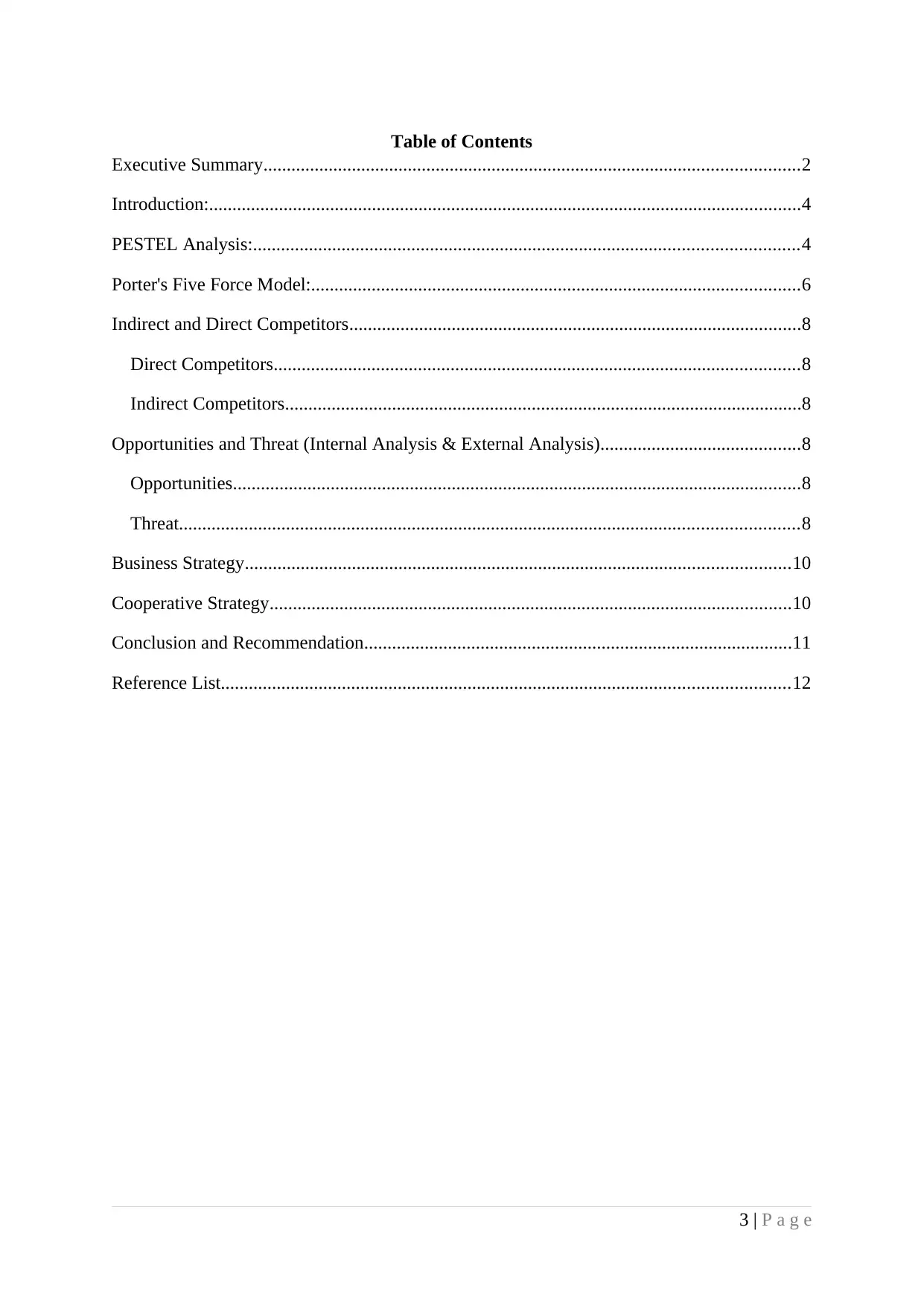
Table of Contents
Executive Summary...................................................................................................................2
Introduction:...............................................................................................................................4
PESTEL Analysis:.....................................................................................................................4
Porter's Five Force Model:.........................................................................................................6
Indirect and Direct Competitors.................................................................................................8
Direct Competitors.................................................................................................................8
Indirect Competitors...............................................................................................................8
Opportunities and Threat (Internal Analysis & External Analysis)...........................................8
Opportunities..........................................................................................................................8
Threat.....................................................................................................................................8
Business Strategy.....................................................................................................................10
Cooperative Strategy................................................................................................................10
Conclusion and Recommendation............................................................................................11
Reference List..........................................................................................................................12
3 | P a g e
Executive Summary...................................................................................................................2
Introduction:...............................................................................................................................4
PESTEL Analysis:.....................................................................................................................4
Porter's Five Force Model:.........................................................................................................6
Indirect and Direct Competitors.................................................................................................8
Direct Competitors.................................................................................................................8
Indirect Competitors...............................................................................................................8
Opportunities and Threat (Internal Analysis & External Analysis)...........................................8
Opportunities..........................................................................................................................8
Threat.....................................................................................................................................8
Business Strategy.....................................................................................................................10
Cooperative Strategy................................................................................................................10
Conclusion and Recommendation............................................................................................11
Reference List..........................................................................................................................12
3 | P a g e
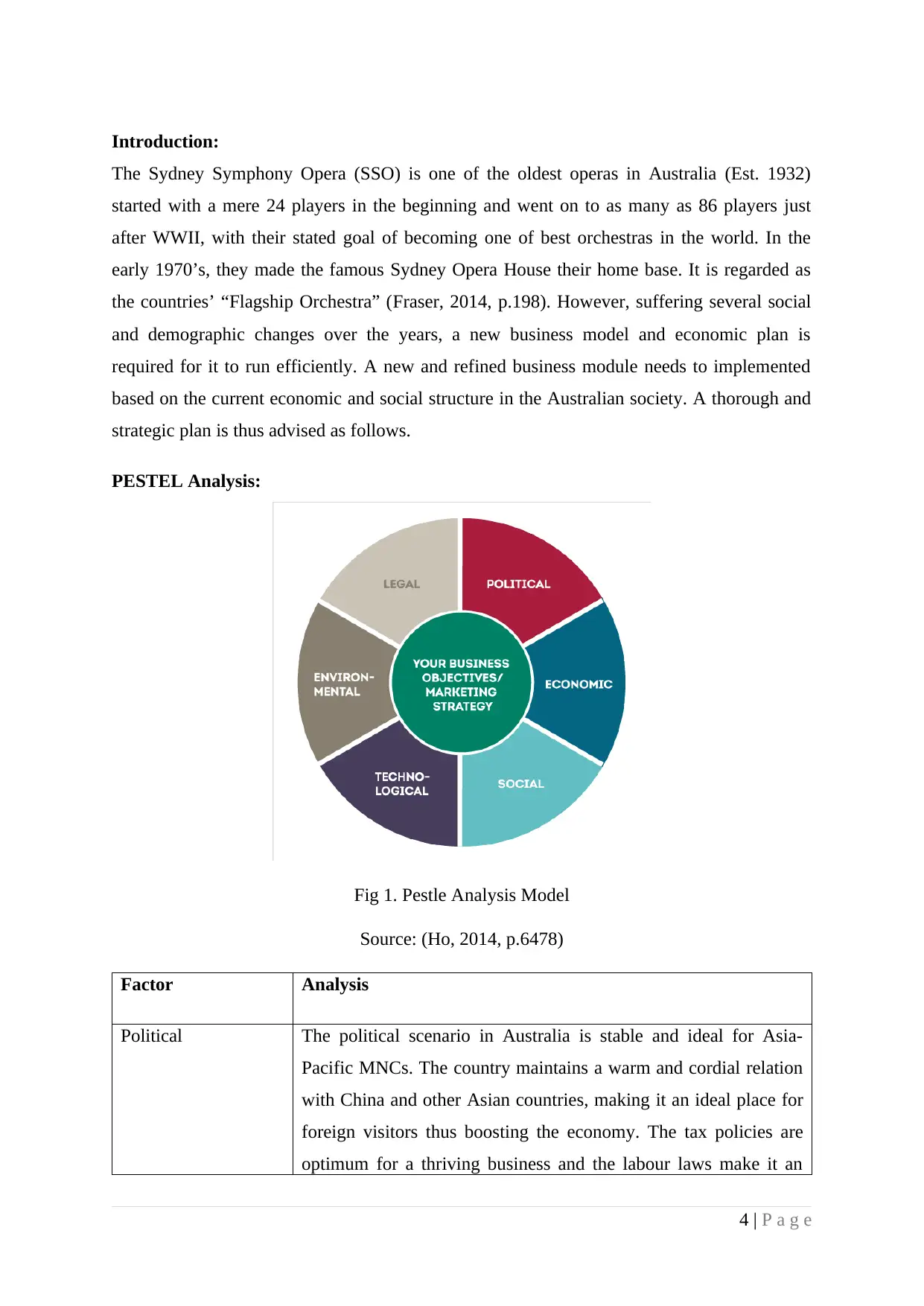
Introduction:
The Sydney Symphony Opera (SSO) is one of the oldest operas in Australia (Est. 1932)
started with a mere 24 players in the beginning and went on to as many as 86 players just
after WWII, with their stated goal of becoming one of best orchestras in the world. In the
early 1970’s, they made the famous Sydney Opera House their home base. It is regarded as
the countries’ “Flagship Orchestra” (Fraser, 2014, p.198). However, suffering several social
and demographic changes over the years, a new business model and economic plan is
required for it to run efficiently. A new and refined business module needs to implemented
based on the current economic and social structure in the Australian society. A thorough and
strategic plan is thus advised as follows.
PESTEL Analysis:
Fig 1. Pestle Analysis Model
Source: (Ho, 2014, p.6478)
Factor Analysis
Political The political scenario in Australia is stable and ideal for Asia-
Pacific MNCs. The country maintains a warm and cordial relation
with China and other Asian countries, making it an ideal place for
foreign visitors thus boosting the economy. The tax policies are
optimum for a thriving business and the labour laws make it an
4 | P a g e
The Sydney Symphony Opera (SSO) is one of the oldest operas in Australia (Est. 1932)
started with a mere 24 players in the beginning and went on to as many as 86 players just
after WWII, with their stated goal of becoming one of best orchestras in the world. In the
early 1970’s, they made the famous Sydney Opera House their home base. It is regarded as
the countries’ “Flagship Orchestra” (Fraser, 2014, p.198). However, suffering several social
and demographic changes over the years, a new business model and economic plan is
required for it to run efficiently. A new and refined business module needs to implemented
based on the current economic and social structure in the Australian society. A thorough and
strategic plan is thus advised as follows.
PESTEL Analysis:
Fig 1. Pestle Analysis Model
Source: (Ho, 2014, p.6478)
Factor Analysis
Political The political scenario in Australia is stable and ideal for Asia-
Pacific MNCs. The country maintains a warm and cordial relation
with China and other Asian countries, making it an ideal place for
foreign visitors thus boosting the economy. The tax policies are
optimum for a thriving business and the labour laws make it an
4 | P a g e
Secure Best Marks with AI Grader
Need help grading? Try our AI Grader for instant feedback on your assignments.
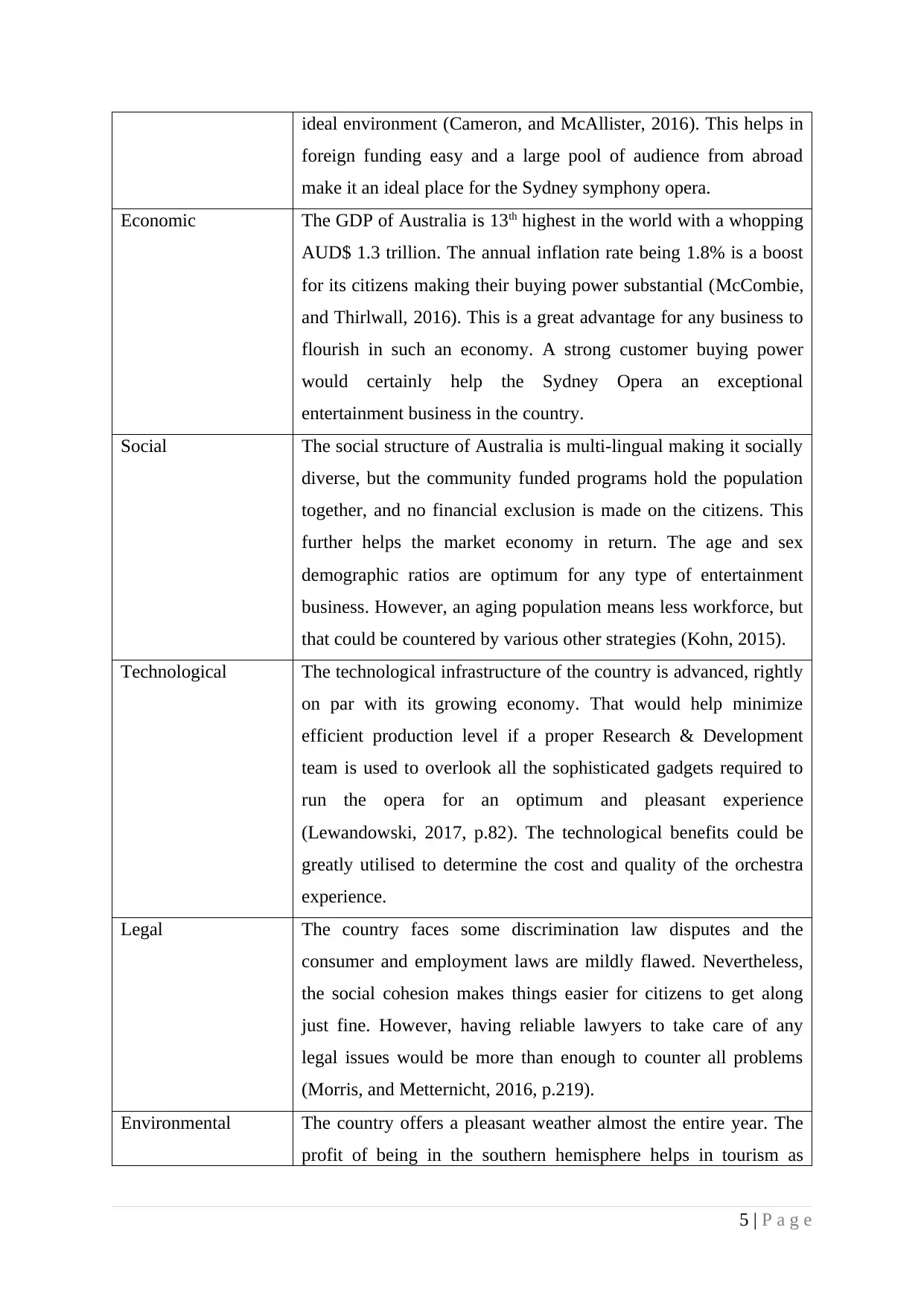
ideal environment (Cameron, and McAllister, 2016). This helps in
foreign funding easy and a large pool of audience from abroad
make it an ideal place for the Sydney symphony opera.
Economic The GDP of Australia is 13th highest in the world with a whopping
AUD$ 1.3 trillion. The annual inflation rate being 1.8% is a boost
for its citizens making their buying power substantial (McCombie,
and Thirlwall, 2016). This is a great advantage for any business to
flourish in such an economy. A strong customer buying power
would certainly help the Sydney Opera an exceptional
entertainment business in the country.
Social The social structure of Australia is multi-lingual making it socially
diverse, but the community funded programs hold the population
together, and no financial exclusion is made on the citizens. This
further helps the market economy in return. The age and sex
demographic ratios are optimum for any type of entertainment
business. However, an aging population means less workforce, but
that could be countered by various other strategies (Kohn, 2015).
Technological The technological infrastructure of the country is advanced, rightly
on par with its growing economy. That would help minimize
efficient production level if a proper Research & Development
team is used to overlook all the sophisticated gadgets required to
run the opera for an optimum and pleasant experience
(Lewandowski, 2017, p.82). The technological benefits could be
greatly utilised to determine the cost and quality of the orchestra
experience.
Legal The country faces some discrimination law disputes and the
consumer and employment laws are mildly flawed. Nevertheless,
the social cohesion makes things easier for citizens to get along
just fine. However, having reliable lawyers to take care of any
legal issues would be more than enough to counter all problems
(Morris, and Metternicht, 2016, p.219).
Environmental The country offers a pleasant weather almost the entire year. The
profit of being in the southern hemisphere helps in tourism as
5 | P a g e
foreign funding easy and a large pool of audience from abroad
make it an ideal place for the Sydney symphony opera.
Economic The GDP of Australia is 13th highest in the world with a whopping
AUD$ 1.3 trillion. The annual inflation rate being 1.8% is a boost
for its citizens making their buying power substantial (McCombie,
and Thirlwall, 2016). This is a great advantage for any business to
flourish in such an economy. A strong customer buying power
would certainly help the Sydney Opera an exceptional
entertainment business in the country.
Social The social structure of Australia is multi-lingual making it socially
diverse, but the community funded programs hold the population
together, and no financial exclusion is made on the citizens. This
further helps the market economy in return. The age and sex
demographic ratios are optimum for any type of entertainment
business. However, an aging population means less workforce, but
that could be countered by various other strategies (Kohn, 2015).
Technological The technological infrastructure of the country is advanced, rightly
on par with its growing economy. That would help minimize
efficient production level if a proper Research & Development
team is used to overlook all the sophisticated gadgets required to
run the opera for an optimum and pleasant experience
(Lewandowski, 2017, p.82). The technological benefits could be
greatly utilised to determine the cost and quality of the orchestra
experience.
Legal The country faces some discrimination law disputes and the
consumer and employment laws are mildly flawed. Nevertheless,
the social cohesion makes things easier for citizens to get along
just fine. However, having reliable lawyers to take care of any
legal issues would be more than enough to counter all problems
(Morris, and Metternicht, 2016, p.219).
Environmental The country offers a pleasant weather almost the entire year. The
profit of being in the southern hemisphere helps in tourism as
5 | P a g e
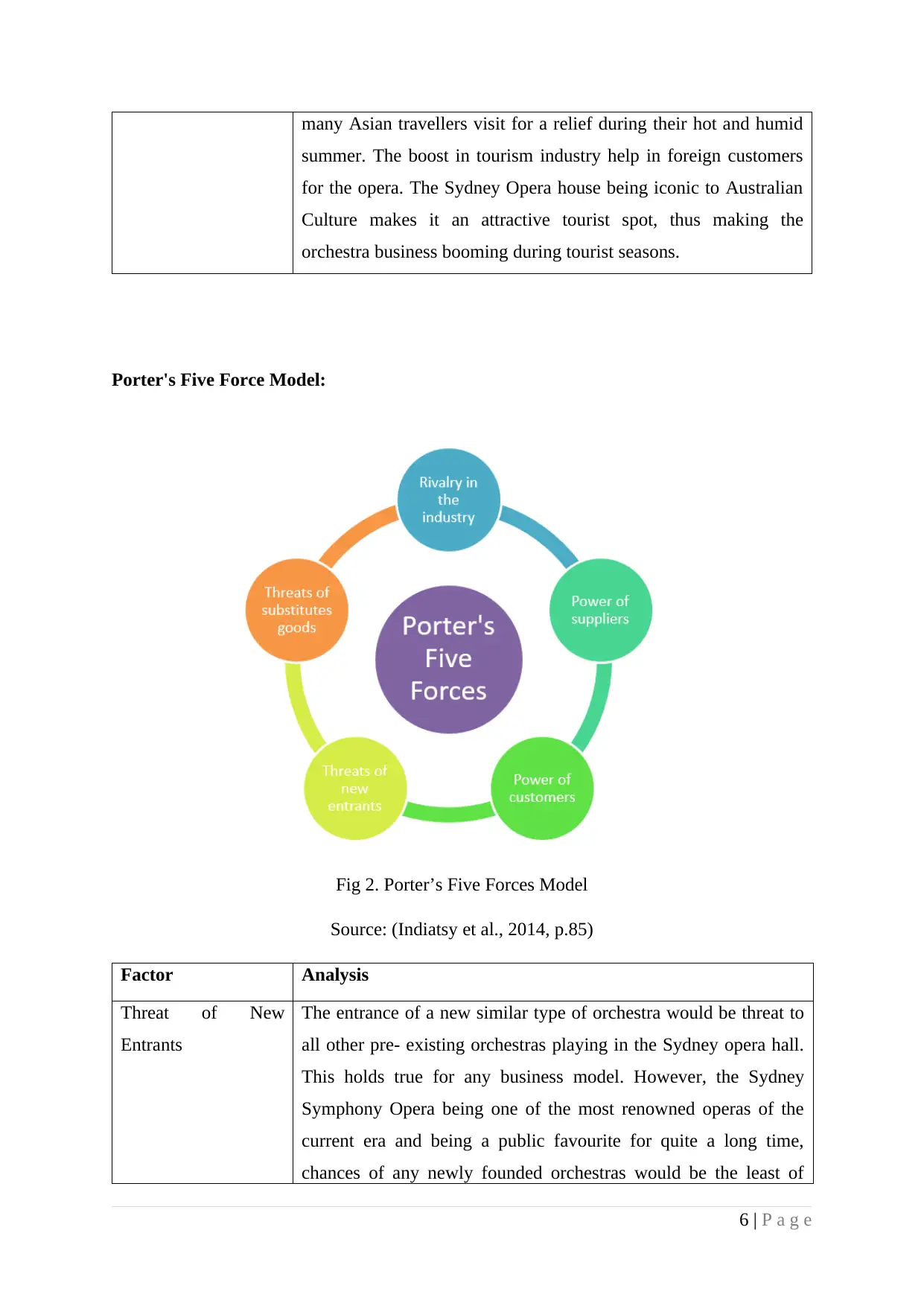
many Asian travellers visit for a relief during their hot and humid
summer. The boost in tourism industry help in foreign customers
for the opera. The Sydney Opera house being iconic to Australian
Culture makes it an attractive tourist spot, thus making the
orchestra business booming during tourist seasons.
Porter's Five Force Model:
Fig 2. Porter’s Five Forces Model
Source: (Indiatsy et al., 2014, p.85)
Factor Analysis
Threat of New
Entrants
The entrance of a new similar type of orchestra would be threat to
all other pre- existing orchestras playing in the Sydney opera hall.
This holds true for any business model. However, the Sydney
Symphony Opera being one of the most renowned operas of the
current era and being a public favourite for quite a long time,
chances of any newly founded orchestras would be the least of
6 | P a g e
summer. The boost in tourism industry help in foreign customers
for the opera. The Sydney Opera house being iconic to Australian
Culture makes it an attractive tourist spot, thus making the
orchestra business booming during tourist seasons.
Porter's Five Force Model:
Fig 2. Porter’s Five Forces Model
Source: (Indiatsy et al., 2014, p.85)
Factor Analysis
Threat of New
Entrants
The entrance of a new similar type of orchestra would be threat to
all other pre- existing orchestras playing in the Sydney opera hall.
This holds true for any business model. However, the Sydney
Symphony Opera being one of the most renowned operas of the
current era and being a public favourite for quite a long time,
chances of any newly founded orchestras would be the least of
6 | P a g e
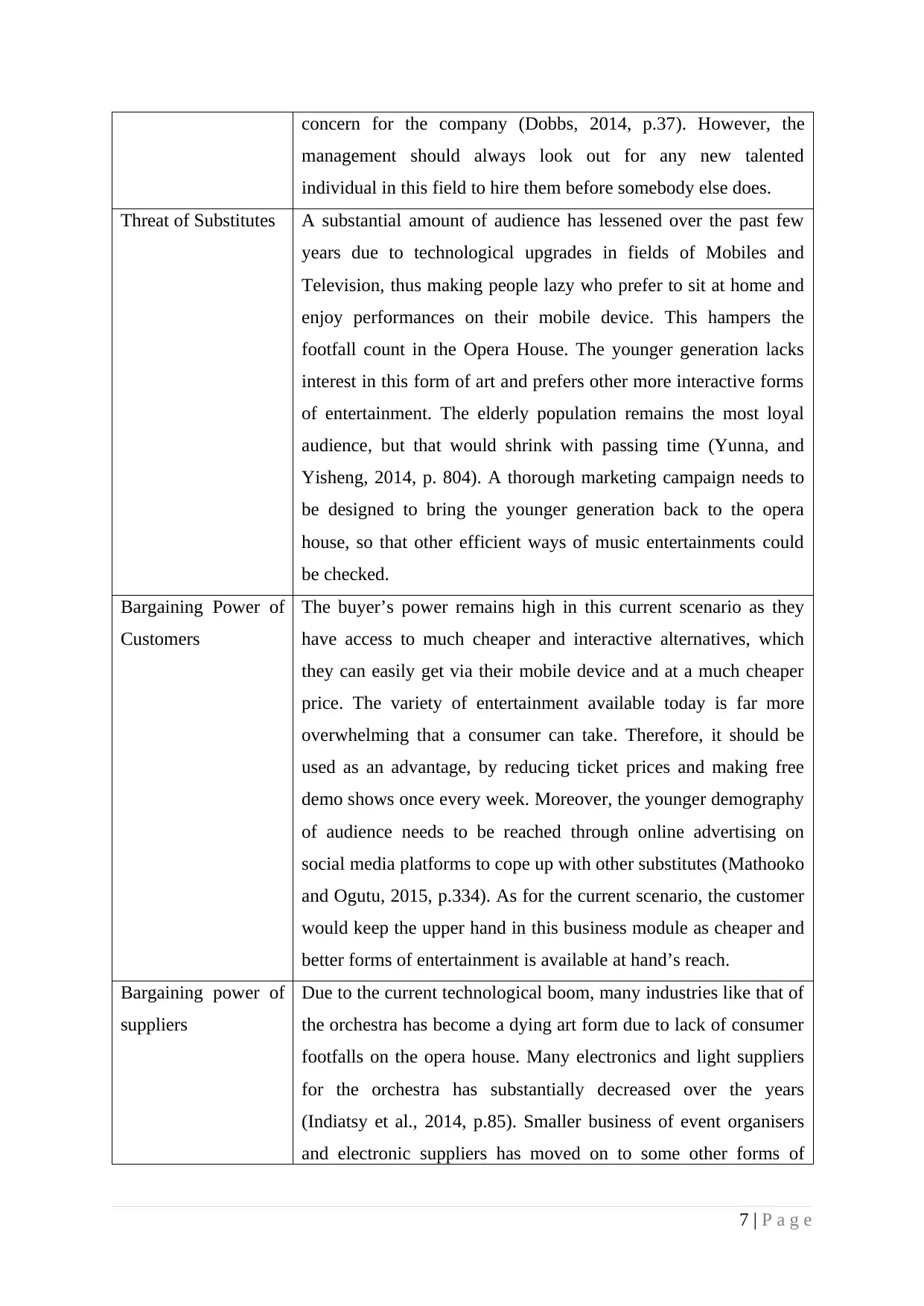
concern for the company (Dobbs, 2014, p.37). However, the
management should always look out for any new talented
individual in this field to hire them before somebody else does.
Threat of Substitutes A substantial amount of audience has lessened over the past few
years due to technological upgrades in fields of Mobiles and
Television, thus making people lazy who prefer to sit at home and
enjoy performances on their mobile device. This hampers the
footfall count in the Opera House. The younger generation lacks
interest in this form of art and prefers other more interactive forms
of entertainment. The elderly population remains the most loyal
audience, but that would shrink with passing time (Yunna, and
Yisheng, 2014, p. 804). A thorough marketing campaign needs to
be designed to bring the younger generation back to the opera
house, so that other efficient ways of music entertainments could
be checked.
Bargaining Power of
Customers
The buyer’s power remains high in this current scenario as they
have access to much cheaper and interactive alternatives, which
they can easily get via their mobile device and at a much cheaper
price. The variety of entertainment available today is far more
overwhelming that a consumer can take. Therefore, it should be
used as an advantage, by reducing ticket prices and making free
demo shows once every week. Moreover, the younger demography
of audience needs to be reached through online advertising on
social media platforms to cope up with other substitutes (Mathooko
and Ogutu, 2015, p.334). As for the current scenario, the customer
would keep the upper hand in this business module as cheaper and
better forms of entertainment is available at hand’s reach.
Bargaining power of
suppliers
Due to the current technological boom, many industries like that of
the orchestra has become a dying art form due to lack of consumer
footfalls on the opera house. Many electronics and light suppliers
for the orchestra has substantially decreased over the years
(Indiatsy et al., 2014, p.85). Smaller business of event organisers
and electronic suppliers has moved on to some other forms of
7 | P a g e
management should always look out for any new talented
individual in this field to hire them before somebody else does.
Threat of Substitutes A substantial amount of audience has lessened over the past few
years due to technological upgrades in fields of Mobiles and
Television, thus making people lazy who prefer to sit at home and
enjoy performances on their mobile device. This hampers the
footfall count in the Opera House. The younger generation lacks
interest in this form of art and prefers other more interactive forms
of entertainment. The elderly population remains the most loyal
audience, but that would shrink with passing time (Yunna, and
Yisheng, 2014, p. 804). A thorough marketing campaign needs to
be designed to bring the younger generation back to the opera
house, so that other efficient ways of music entertainments could
be checked.
Bargaining Power of
Customers
The buyer’s power remains high in this current scenario as they
have access to much cheaper and interactive alternatives, which
they can easily get via their mobile device and at a much cheaper
price. The variety of entertainment available today is far more
overwhelming that a consumer can take. Therefore, it should be
used as an advantage, by reducing ticket prices and making free
demo shows once every week. Moreover, the younger demography
of audience needs to be reached through online advertising on
social media platforms to cope up with other substitutes (Mathooko
and Ogutu, 2015, p.334). As for the current scenario, the customer
would keep the upper hand in this business module as cheaper and
better forms of entertainment is available at hand’s reach.
Bargaining power of
suppliers
Due to the current technological boom, many industries like that of
the orchestra has become a dying art form due to lack of consumer
footfalls on the opera house. Many electronics and light suppliers
for the orchestra has substantially decreased over the years
(Indiatsy et al., 2014, p.85). Smaller business of event organisers
and electronic suppliers has moved on to some other forms of
7 | P a g e
Paraphrase This Document
Need a fresh take? Get an instant paraphrase of this document with our AI Paraphraser
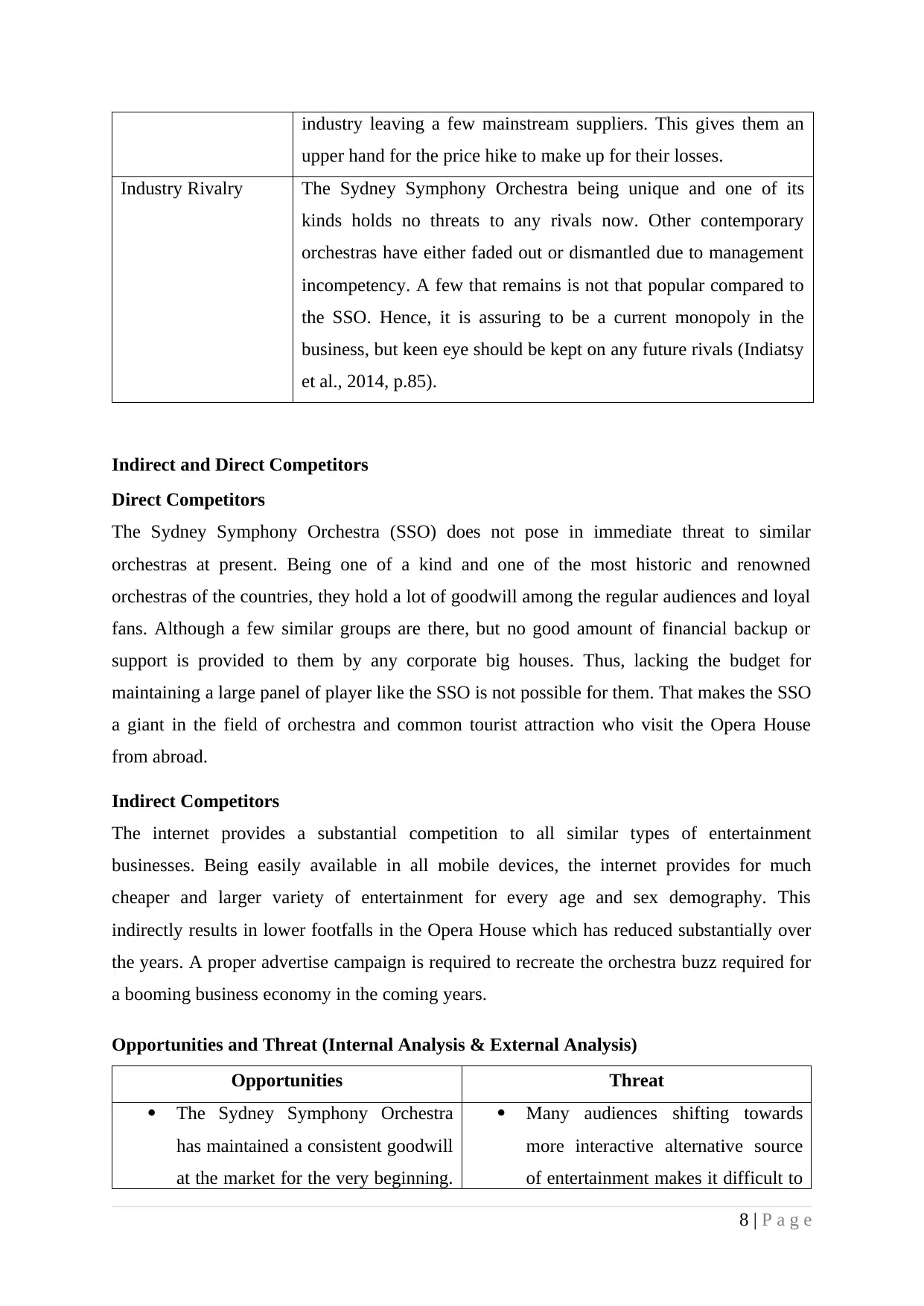
industry leaving a few mainstream suppliers. This gives them an
upper hand for the price hike to make up for their losses.
Industry Rivalry The Sydney Symphony Orchestra being unique and one of its
kinds holds no threats to any rivals now. Other contemporary
orchestras have either faded out or dismantled due to management
incompetency. A few that remains is not that popular compared to
the SSO. Hence, it is assuring to be a current monopoly in the
business, but keen eye should be kept on any future rivals (Indiatsy
et al., 2014, p.85).
Indirect and Direct Competitors
Direct Competitors
The Sydney Symphony Orchestra (SSO) does not pose in immediate threat to similar
orchestras at present. Being one of a kind and one of the most historic and renowned
orchestras of the countries, they hold a lot of goodwill among the regular audiences and loyal
fans. Although a few similar groups are there, but no good amount of financial backup or
support is provided to them by any corporate big houses. Thus, lacking the budget for
maintaining a large panel of player like the SSO is not possible for them. That makes the SSO
a giant in the field of orchestra and common tourist attraction who visit the Opera House
from abroad.
Indirect Competitors
The internet provides a substantial competition to all similar types of entertainment
businesses. Being easily available in all mobile devices, the internet provides for much
cheaper and larger variety of entertainment for every age and sex demography. This
indirectly results in lower footfalls in the Opera House which has reduced substantially over
the years. A proper advertise campaign is required to recreate the orchestra buzz required for
a booming business economy in the coming years.
Opportunities and Threat (Internal Analysis & External Analysis)
Opportunities Threat
The Sydney Symphony Orchestra
has maintained a consistent goodwill
at the market for the very beginning.
Many audiences shifting towards
more interactive alternative source
of entertainment makes it difficult to
8 | P a g e
upper hand for the price hike to make up for their losses.
Industry Rivalry The Sydney Symphony Orchestra being unique and one of its
kinds holds no threats to any rivals now. Other contemporary
orchestras have either faded out or dismantled due to management
incompetency. A few that remains is not that popular compared to
the SSO. Hence, it is assuring to be a current monopoly in the
business, but keen eye should be kept on any future rivals (Indiatsy
et al., 2014, p.85).
Indirect and Direct Competitors
Direct Competitors
The Sydney Symphony Orchestra (SSO) does not pose in immediate threat to similar
orchestras at present. Being one of a kind and one of the most historic and renowned
orchestras of the countries, they hold a lot of goodwill among the regular audiences and loyal
fans. Although a few similar groups are there, but no good amount of financial backup or
support is provided to them by any corporate big houses. Thus, lacking the budget for
maintaining a large panel of player like the SSO is not possible for them. That makes the SSO
a giant in the field of orchestra and common tourist attraction who visit the Opera House
from abroad.
Indirect Competitors
The internet provides a substantial competition to all similar types of entertainment
businesses. Being easily available in all mobile devices, the internet provides for much
cheaper and larger variety of entertainment for every age and sex demography. This
indirectly results in lower footfalls in the Opera House which has reduced substantially over
the years. A proper advertise campaign is required to recreate the orchestra buzz required for
a booming business economy in the coming years.
Opportunities and Threat (Internal Analysis & External Analysis)
Opportunities Threat
The Sydney Symphony Orchestra
has maintained a consistent goodwill
at the market for the very beginning.
Many audiences shifting towards
more interactive alternative source
of entertainment makes it difficult to
8 | P a g e
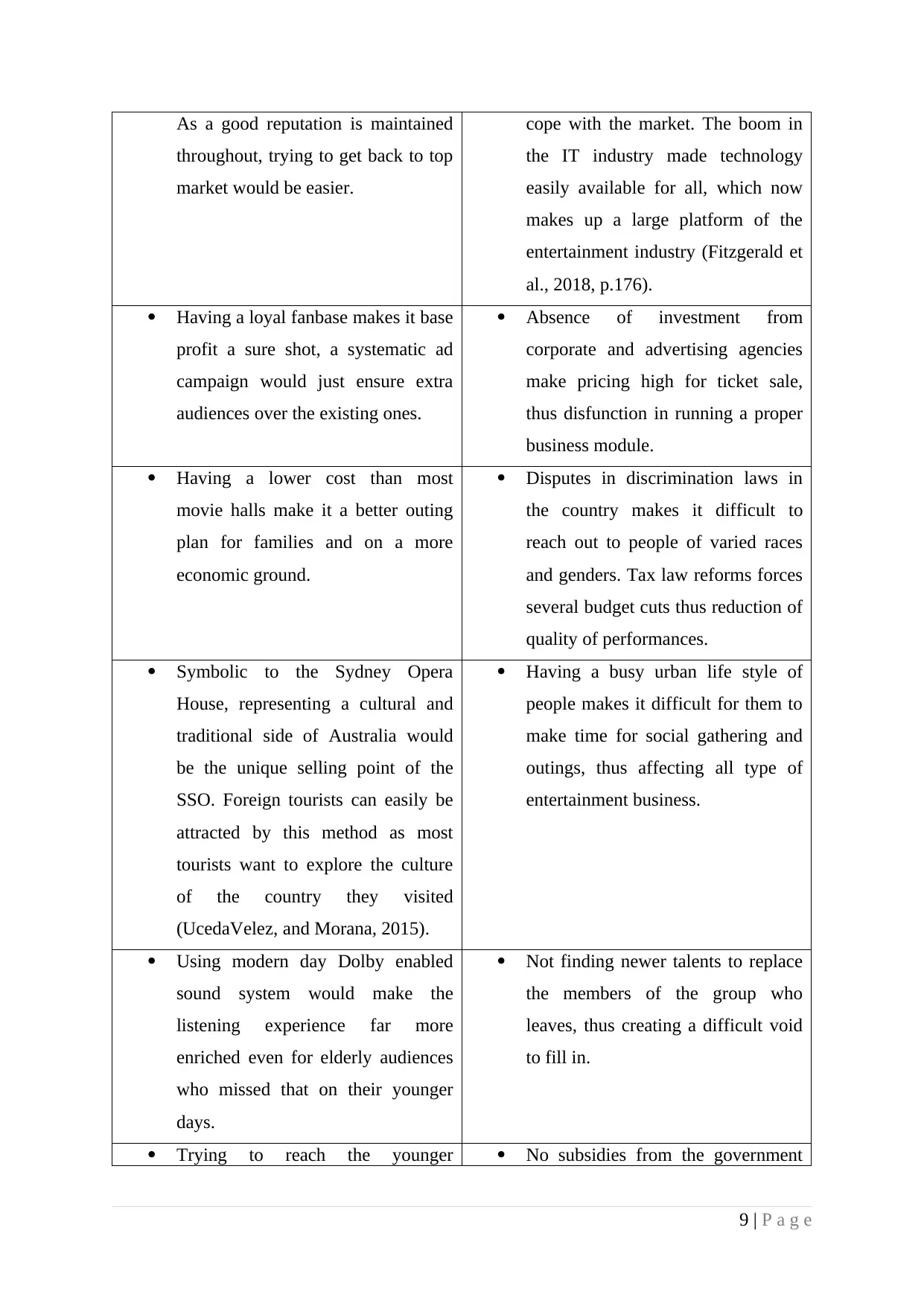
As a good reputation is maintained
throughout, trying to get back to top
market would be easier.
cope with the market. The boom in
the IT industry made technology
easily available for all, which now
makes up a large platform of the
entertainment industry (Fitzgerald et
al., 2018, p.176).
Having a loyal fanbase makes it base
profit a sure shot, a systematic ad
campaign would just ensure extra
audiences over the existing ones.
Absence of investment from
corporate and advertising agencies
make pricing high for ticket sale,
thus disfunction in running a proper
business module.
Having a lower cost than most
movie halls make it a better outing
plan for families and on a more
economic ground.
Disputes in discrimination laws in
the country makes it difficult to
reach out to people of varied races
and genders. Tax law reforms forces
several budget cuts thus reduction of
quality of performances.
Symbolic to the Sydney Opera
House, representing a cultural and
traditional side of Australia would
be the unique selling point of the
SSO. Foreign tourists can easily be
attracted by this method as most
tourists want to explore the culture
of the country they visited
(UcedaVelez, and Morana, 2015).
Having a busy urban life style of
people makes it difficult for them to
make time for social gathering and
outings, thus affecting all type of
entertainment business.
Using modern day Dolby enabled
sound system would make the
listening experience far more
enriched even for elderly audiences
who missed that on their younger
days.
Not finding newer talents to replace
the members of the group who
leaves, thus creating a difficult void
to fill in.
Trying to reach the younger No subsidies from the government
9 | P a g e
throughout, trying to get back to top
market would be easier.
cope with the market. The boom in
the IT industry made technology
easily available for all, which now
makes up a large platform of the
entertainment industry (Fitzgerald et
al., 2018, p.176).
Having a loyal fanbase makes it base
profit a sure shot, a systematic ad
campaign would just ensure extra
audiences over the existing ones.
Absence of investment from
corporate and advertising agencies
make pricing high for ticket sale,
thus disfunction in running a proper
business module.
Having a lower cost than most
movie halls make it a better outing
plan for families and on a more
economic ground.
Disputes in discrimination laws in
the country makes it difficult to
reach out to people of varied races
and genders. Tax law reforms forces
several budget cuts thus reduction of
quality of performances.
Symbolic to the Sydney Opera
House, representing a cultural and
traditional side of Australia would
be the unique selling point of the
SSO. Foreign tourists can easily be
attracted by this method as most
tourists want to explore the culture
of the country they visited
(UcedaVelez, and Morana, 2015).
Having a busy urban life style of
people makes it difficult for them to
make time for social gathering and
outings, thus affecting all type of
entertainment business.
Using modern day Dolby enabled
sound system would make the
listening experience far more
enriched even for elderly audiences
who missed that on their younger
days.
Not finding newer talents to replace
the members of the group who
leaves, thus creating a difficult void
to fill in.
Trying to reach the younger No subsidies from the government
9 | P a g e
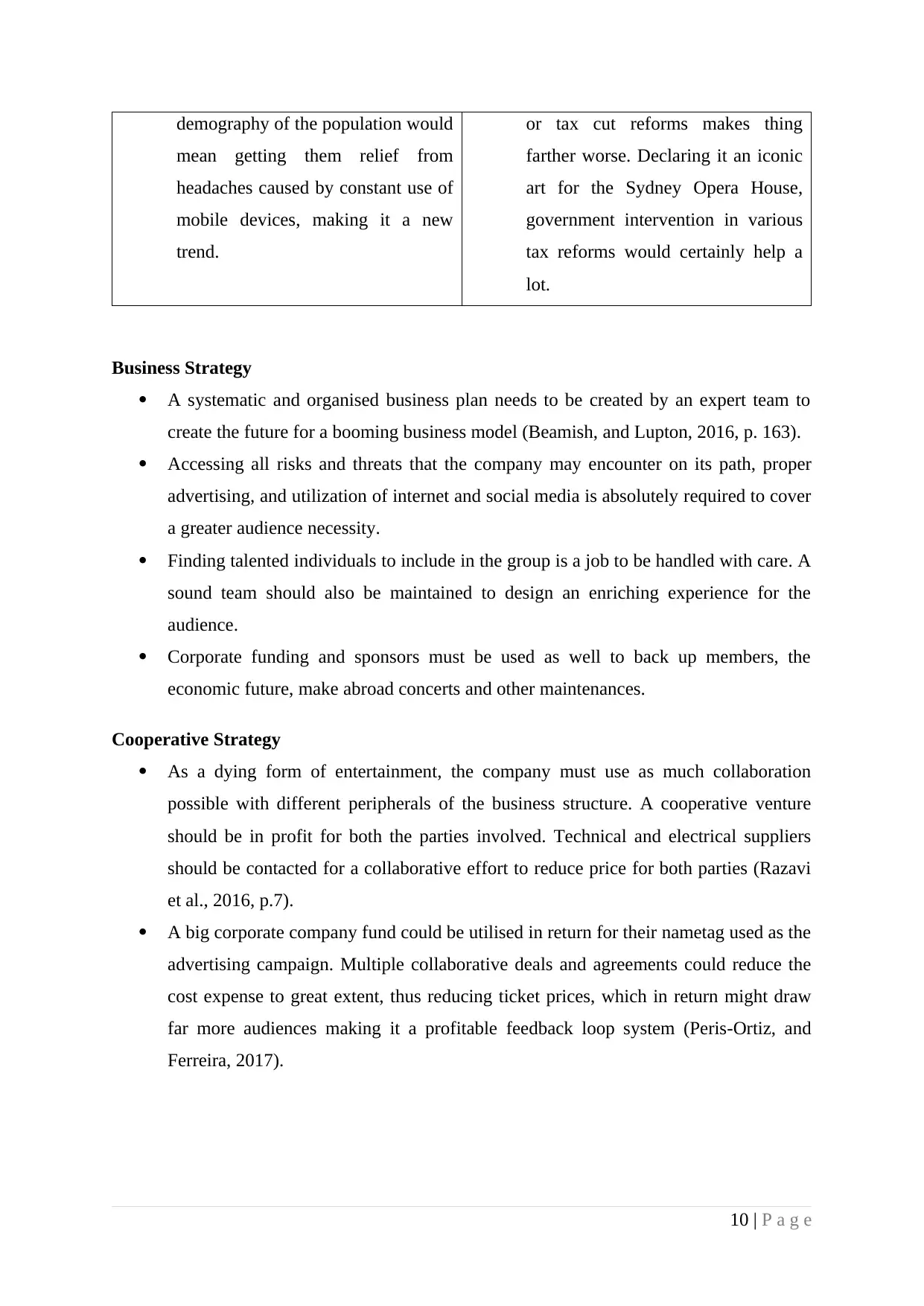
demography of the population would
mean getting them relief from
headaches caused by constant use of
mobile devices, making it a new
trend.
or tax cut reforms makes thing
farther worse. Declaring it an iconic
art for the Sydney Opera House,
government intervention in various
tax reforms would certainly help a
lot.
Business Strategy
A systematic and organised business plan needs to be created by an expert team to
create the future for a booming business model (Beamish, and Lupton, 2016, p. 163).
Accessing all risks and threats that the company may encounter on its path, proper
advertising, and utilization of internet and social media is absolutely required to cover
a greater audience necessity.
Finding talented individuals to include in the group is a job to be handled with care. A
sound team should also be maintained to design an enriching experience for the
audience.
Corporate funding and sponsors must be used as well to back up members, the
economic future, make abroad concerts and other maintenances.
Cooperative Strategy
As a dying form of entertainment, the company must use as much collaboration
possible with different peripherals of the business structure. A cooperative venture
should be in profit for both the parties involved. Technical and electrical suppliers
should be contacted for a collaborative effort to reduce price for both parties (Razavi
et al., 2016, p.7).
A big corporate company fund could be utilised in return for their nametag used as the
advertising campaign. Multiple collaborative deals and agreements could reduce the
cost expense to great extent, thus reducing ticket prices, which in return might draw
far more audiences making it a profitable feedback loop system (Peris-Ortiz, and
Ferreira, 2017).
10 | P a g e
mean getting them relief from
headaches caused by constant use of
mobile devices, making it a new
trend.
or tax cut reforms makes thing
farther worse. Declaring it an iconic
art for the Sydney Opera House,
government intervention in various
tax reforms would certainly help a
lot.
Business Strategy
A systematic and organised business plan needs to be created by an expert team to
create the future for a booming business model (Beamish, and Lupton, 2016, p. 163).
Accessing all risks and threats that the company may encounter on its path, proper
advertising, and utilization of internet and social media is absolutely required to cover
a greater audience necessity.
Finding talented individuals to include in the group is a job to be handled with care. A
sound team should also be maintained to design an enriching experience for the
audience.
Corporate funding and sponsors must be used as well to back up members, the
economic future, make abroad concerts and other maintenances.
Cooperative Strategy
As a dying form of entertainment, the company must use as much collaboration
possible with different peripherals of the business structure. A cooperative venture
should be in profit for both the parties involved. Technical and electrical suppliers
should be contacted for a collaborative effort to reduce price for both parties (Razavi
et al., 2016, p.7).
A big corporate company fund could be utilised in return for their nametag used as the
advertising campaign. Multiple collaborative deals and agreements could reduce the
cost expense to great extent, thus reducing ticket prices, which in return might draw
far more audiences making it a profitable feedback loop system (Peris-Ortiz, and
Ferreira, 2017).
10 | P a g e
Secure Best Marks with AI Grader
Need help grading? Try our AI Grader for instant feedback on your assignments.
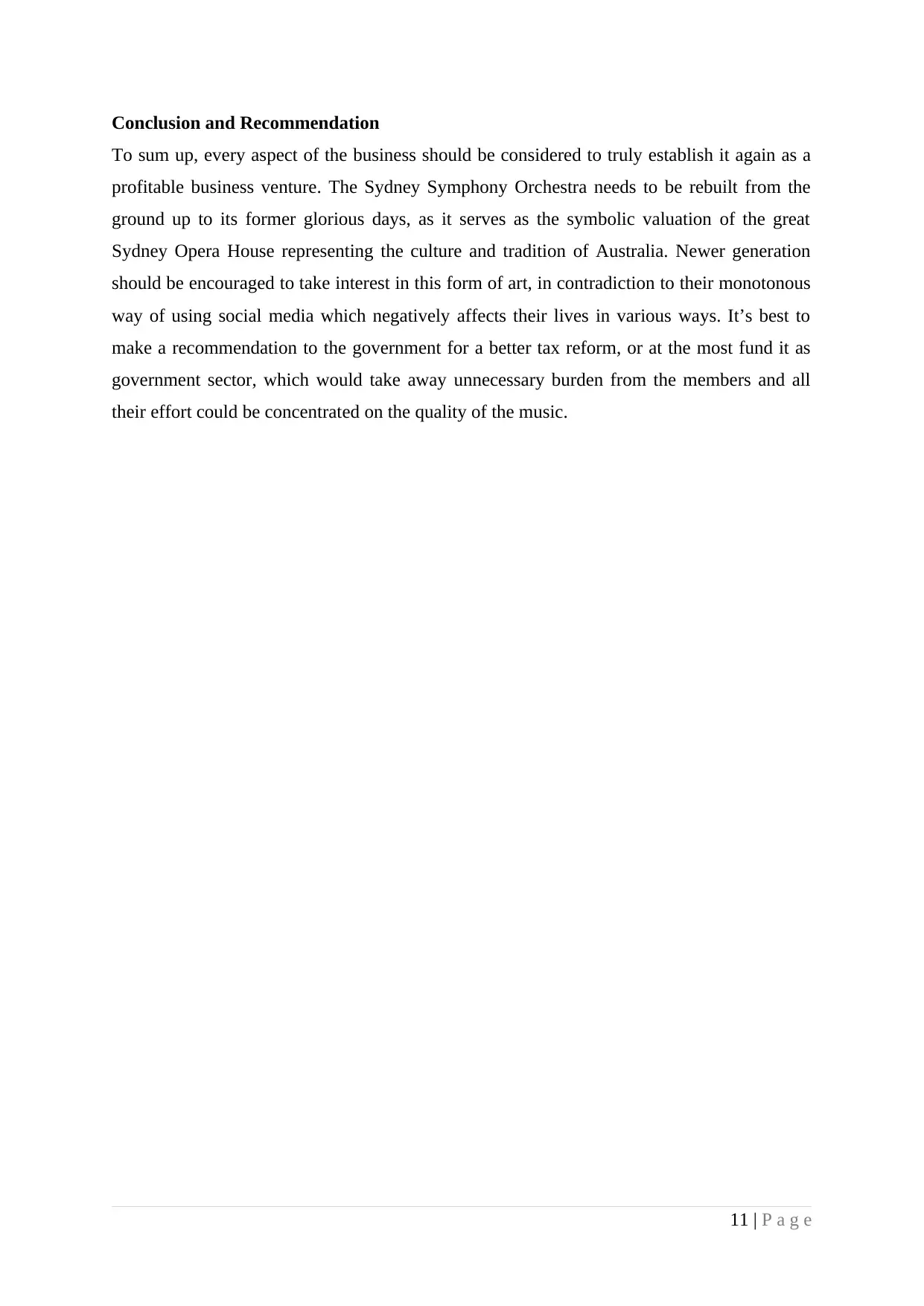
Conclusion and Recommendation
To sum up, every aspect of the business should be considered to truly establish it again as a
profitable business venture. The Sydney Symphony Orchestra needs to be rebuilt from the
ground up to its former glorious days, as it serves as the symbolic valuation of the great
Sydney Opera House representing the culture and tradition of Australia. Newer generation
should be encouraged to take interest in this form of art, in contradiction to their monotonous
way of using social media which negatively affects their lives in various ways. It’s best to
make a recommendation to the government for a better tax reform, or at the most fund it as
government sector, which would take away unnecessary burden from the members and all
their effort could be concentrated on the quality of the music.
11 | P a g e
To sum up, every aspect of the business should be considered to truly establish it again as a
profitable business venture. The Sydney Symphony Orchestra needs to be rebuilt from the
ground up to its former glorious days, as it serves as the symbolic valuation of the great
Sydney Opera House representing the culture and tradition of Australia. Newer generation
should be encouraged to take interest in this form of art, in contradiction to their monotonous
way of using social media which negatively affects their lives in various ways. It’s best to
make a recommendation to the government for a better tax reform, or at the most fund it as
government sector, which would take away unnecessary burden from the members and all
their effort could be concentrated on the quality of the music.
11 | P a g e
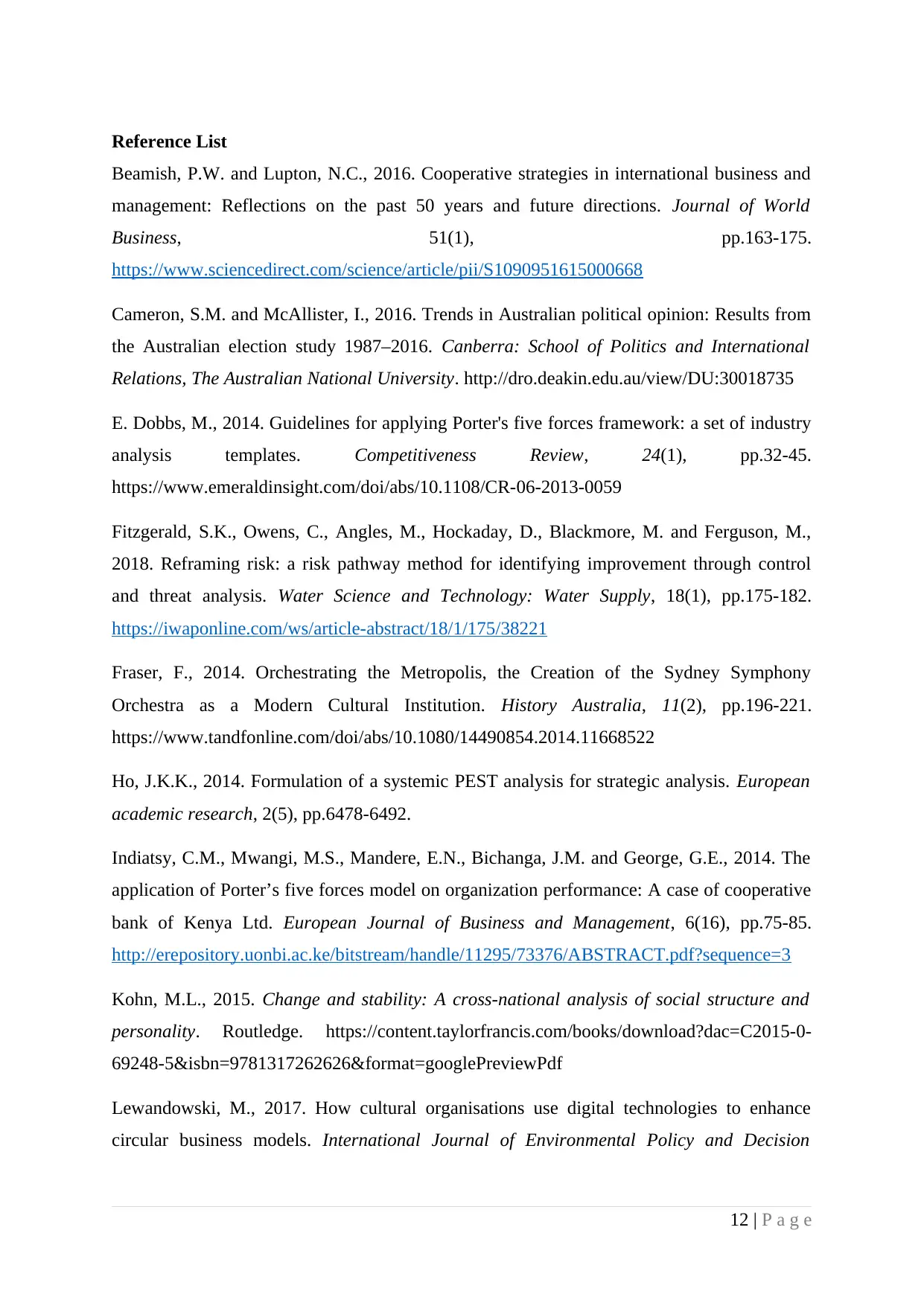
Reference List
Beamish, P.W. and Lupton, N.C., 2016. Cooperative strategies in international business and
management: Reflections on the past 50 years and future directions. Journal of World
Business, 51(1), pp.163-175.
https://www.sciencedirect.com/science/article/pii/S1090951615000668
Cameron, S.M. and McAllister, I., 2016. Trends in Australian political opinion: Results from
the Australian election study 1987–2016. Canberra: School of Politics and International
Relations, The Australian National University. http://dro.deakin.edu.au/view/DU:30018735
E. Dobbs, M., 2014. Guidelines for applying Porter's five forces framework: a set of industry
analysis templates. Competitiveness Review, 24(1), pp.32-45.
https://www.emeraldinsight.com/doi/abs/10.1108/CR-06-2013-0059
Fitzgerald, S.K., Owens, C., Angles, M., Hockaday, D., Blackmore, M. and Ferguson, M.,
2018. Reframing risk: a risk pathway method for identifying improvement through control
and threat analysis. Water Science and Technology: Water Supply, 18(1), pp.175-182.
https://iwaponline.com/ws/article-abstract/18/1/175/38221
Fraser, F., 2014. Orchestrating the Metropolis, the Creation of the Sydney Symphony
Orchestra as a Modern Cultural Institution. History Australia, 11(2), pp.196-221.
https://www.tandfonline.com/doi/abs/10.1080/14490854.2014.11668522
Ho, J.K.K., 2014. Formulation of a systemic PEST analysis for strategic analysis. European
academic research, 2(5), pp.6478-6492.
Indiatsy, C.M., Mwangi, M.S., Mandere, E.N., Bichanga, J.M. and George, G.E., 2014. The
application of Porter’s five forces model on organization performance: A case of cooperative
bank of Kenya Ltd. European Journal of Business and Management, 6(16), pp.75-85.
http://erepository.uonbi.ac.ke/bitstream/handle/11295/73376/ABSTRACT.pdf?sequence=3
Kohn, M.L., 2015. Change and stability: A cross-national analysis of social structure and
personality. Routledge. https://content.taylorfrancis.com/books/download?dac=C2015-0-
69248-5&isbn=9781317262626&format=googlePreviewPdf
Lewandowski, M., 2017. How cultural organisations use digital technologies to enhance
circular business models. International Journal of Environmental Policy and Decision
12 | P a g e
Beamish, P.W. and Lupton, N.C., 2016. Cooperative strategies in international business and
management: Reflections on the past 50 years and future directions. Journal of World
Business, 51(1), pp.163-175.
https://www.sciencedirect.com/science/article/pii/S1090951615000668
Cameron, S.M. and McAllister, I., 2016. Trends in Australian political opinion: Results from
the Australian election study 1987–2016. Canberra: School of Politics and International
Relations, The Australian National University. http://dro.deakin.edu.au/view/DU:30018735
E. Dobbs, M., 2014. Guidelines for applying Porter's five forces framework: a set of industry
analysis templates. Competitiveness Review, 24(1), pp.32-45.
https://www.emeraldinsight.com/doi/abs/10.1108/CR-06-2013-0059
Fitzgerald, S.K., Owens, C., Angles, M., Hockaday, D., Blackmore, M. and Ferguson, M.,
2018. Reframing risk: a risk pathway method for identifying improvement through control
and threat analysis. Water Science and Technology: Water Supply, 18(1), pp.175-182.
https://iwaponline.com/ws/article-abstract/18/1/175/38221
Fraser, F., 2014. Orchestrating the Metropolis, the Creation of the Sydney Symphony
Orchestra as a Modern Cultural Institution. History Australia, 11(2), pp.196-221.
https://www.tandfonline.com/doi/abs/10.1080/14490854.2014.11668522
Ho, J.K.K., 2014. Formulation of a systemic PEST analysis for strategic analysis. European
academic research, 2(5), pp.6478-6492.
Indiatsy, C.M., Mwangi, M.S., Mandere, E.N., Bichanga, J.M. and George, G.E., 2014. The
application of Porter’s five forces model on organization performance: A case of cooperative
bank of Kenya Ltd. European Journal of Business and Management, 6(16), pp.75-85.
http://erepository.uonbi.ac.ke/bitstream/handle/11295/73376/ABSTRACT.pdf?sequence=3
Kohn, M.L., 2015. Change and stability: A cross-national analysis of social structure and
personality. Routledge. https://content.taylorfrancis.com/books/download?dac=C2015-0-
69248-5&isbn=9781317262626&format=googlePreviewPdf
Lewandowski, M., 2017. How cultural organisations use digital technologies to enhance
circular business models. International Journal of Environmental Policy and Decision
12 | P a g e
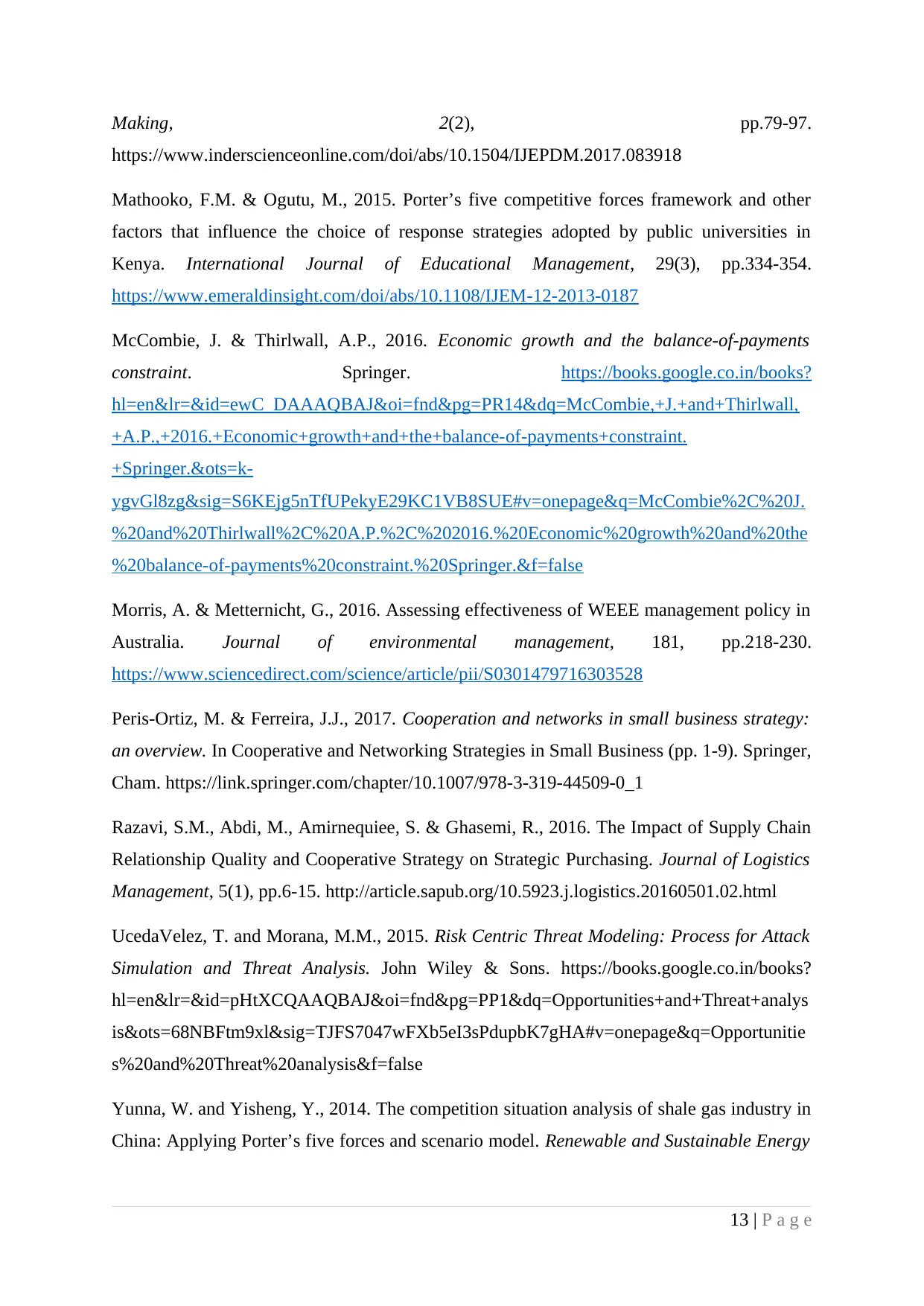
Making, 2(2), pp.79-97.
https://www.inderscienceonline.com/doi/abs/10.1504/IJEPDM.2017.083918
Mathooko, F.M. & Ogutu, M., 2015. Porter’s five competitive forces framework and other
factors that influence the choice of response strategies adopted by public universities in
Kenya. International Journal of Educational Management, 29(3), pp.334-354.
https://www.emeraldinsight.com/doi/abs/10.1108/IJEM-12-2013-0187
McCombie, J. & Thirlwall, A.P., 2016. Economic growth and the balance-of-payments
constraint. Springer. https://books.google.co.in/books?
hl=en&lr=&id=ewC_DAAAQBAJ&oi=fnd&pg=PR14&dq=McCombie,+J.+and+Thirlwall,
+A.P.,+2016.+Economic+growth+and+the+balance-of-payments+constraint.
+Springer.&ots=k-
ygvGl8zg&sig=S6KEjg5nTfUPekyE29KC1VB8SUE#v=onepage&q=McCombie%2C%20J.
%20and%20Thirlwall%2C%20A.P.%2C%202016.%20Economic%20growth%20and%20the
%20balance-of-payments%20constraint.%20Springer.&f=false
Morris, A. & Metternicht, G., 2016. Assessing effectiveness of WEEE management policy in
Australia. Journal of environmental management, 181, pp.218-230.
https://www.sciencedirect.com/science/article/pii/S0301479716303528
Peris-Ortiz, M. & Ferreira, J.J., 2017. Cooperation and networks in small business strategy:
an overview. In Cooperative and Networking Strategies in Small Business (pp. 1-9). Springer,
Cham. https://link.springer.com/chapter/10.1007/978-3-319-44509-0_1
Razavi, S.M., Abdi, M., Amirnequiee, S. & Ghasemi, R., 2016. The Impact of Supply Chain
Relationship Quality and Cooperative Strategy on Strategic Purchasing. Journal of Logistics
Management, 5(1), pp.6-15. http://article.sapub.org/10.5923.j.logistics.20160501.02.html
UcedaVelez, T. and Morana, M.M., 2015. Risk Centric Threat Modeling: Process for Attack
Simulation and Threat Analysis. John Wiley & Sons. https://books.google.co.in/books?
hl=en&lr=&id=pHtXCQAAQBAJ&oi=fnd&pg=PP1&dq=Opportunities+and+Threat+analys
is&ots=68NBFtm9xl&sig=TJFS7047wFXb5eI3sPdupbK7gHA#v=onepage&q=Opportunitie
s%20and%20Threat%20analysis&f=false
Yunna, W. and Yisheng, Y., 2014. The competition situation analysis of shale gas industry in
China: Applying Porter’s five forces and scenario model. Renewable and Sustainable Energy
13 | P a g e
https://www.inderscienceonline.com/doi/abs/10.1504/IJEPDM.2017.083918
Mathooko, F.M. & Ogutu, M., 2015. Porter’s five competitive forces framework and other
factors that influence the choice of response strategies adopted by public universities in
Kenya. International Journal of Educational Management, 29(3), pp.334-354.
https://www.emeraldinsight.com/doi/abs/10.1108/IJEM-12-2013-0187
McCombie, J. & Thirlwall, A.P., 2016. Economic growth and the balance-of-payments
constraint. Springer. https://books.google.co.in/books?
hl=en&lr=&id=ewC_DAAAQBAJ&oi=fnd&pg=PR14&dq=McCombie,+J.+and+Thirlwall,
+A.P.,+2016.+Economic+growth+and+the+balance-of-payments+constraint.
+Springer.&ots=k-
ygvGl8zg&sig=S6KEjg5nTfUPekyE29KC1VB8SUE#v=onepage&q=McCombie%2C%20J.
%20and%20Thirlwall%2C%20A.P.%2C%202016.%20Economic%20growth%20and%20the
%20balance-of-payments%20constraint.%20Springer.&f=false
Morris, A. & Metternicht, G., 2016. Assessing effectiveness of WEEE management policy in
Australia. Journal of environmental management, 181, pp.218-230.
https://www.sciencedirect.com/science/article/pii/S0301479716303528
Peris-Ortiz, M. & Ferreira, J.J., 2017. Cooperation and networks in small business strategy:
an overview. In Cooperative and Networking Strategies in Small Business (pp. 1-9). Springer,
Cham. https://link.springer.com/chapter/10.1007/978-3-319-44509-0_1
Razavi, S.M., Abdi, M., Amirnequiee, S. & Ghasemi, R., 2016. The Impact of Supply Chain
Relationship Quality and Cooperative Strategy on Strategic Purchasing. Journal of Logistics
Management, 5(1), pp.6-15. http://article.sapub.org/10.5923.j.logistics.20160501.02.html
UcedaVelez, T. and Morana, M.M., 2015. Risk Centric Threat Modeling: Process for Attack
Simulation and Threat Analysis. John Wiley & Sons. https://books.google.co.in/books?
hl=en&lr=&id=pHtXCQAAQBAJ&oi=fnd&pg=PP1&dq=Opportunities+and+Threat+analys
is&ots=68NBFtm9xl&sig=TJFS7047wFXb5eI3sPdupbK7gHA#v=onepage&q=Opportunitie
s%20and%20Threat%20analysis&f=false
Yunna, W. and Yisheng, Y., 2014. The competition situation analysis of shale gas industry in
China: Applying Porter’s five forces and scenario model. Renewable and Sustainable Energy
13 | P a g e
Paraphrase This Document
Need a fresh take? Get an instant paraphrase of this document with our AI Paraphraser
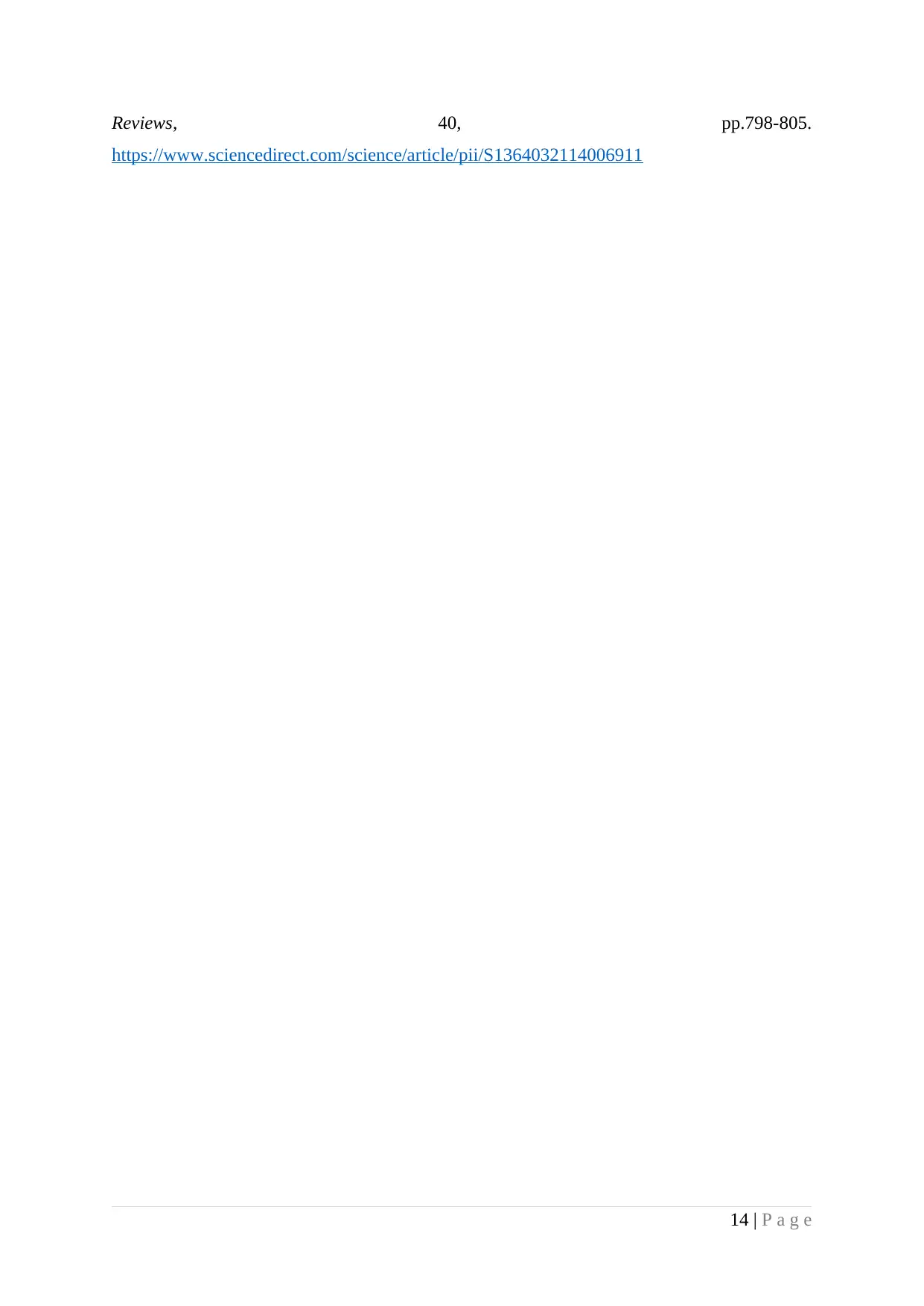
Reviews, 40, pp.798-805.
https://www.sciencedirect.com/science/article/pii/S1364032114006911
14 | P a g e
https://www.sciencedirect.com/science/article/pii/S1364032114006911
14 | P a g e
1 out of 14
Related Documents
Your All-in-One AI-Powered Toolkit for Academic Success.
+13062052269
info@desklib.com
Available 24*7 on WhatsApp / Email
![[object Object]](/_next/static/media/star-bottom.7253800d.svg)
Unlock your academic potential
© 2024 | Zucol Services PVT LTD | All rights reserved.





